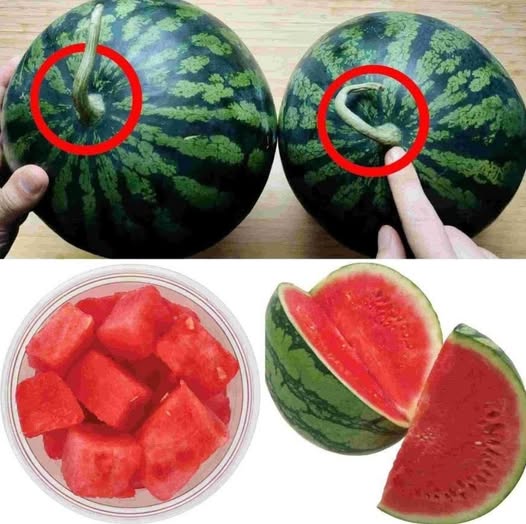How to Pick the Perfectly Sweet Watermelon: Tips for a Juicy and Flavorful Fruit
There’s nothing quite like biting into a cold, sweet watermelon on a hot summer day. Crisp, juicy, and bursting with natural sugar, a perfectly ripe watermelon is a treat that never goes out of season. But if you’ve ever come home with a bland, watery, or mealy melon, you know the disappointment of picking the wrong one.
Choosing a ripe watermelon isn’t just luck—it’s a skill. And once you learn what to look for, you’ll be picking sweet, flavorful melons every time. In this article, we share expert tips and proven tricks to help you identify the ripest, juiciest watermelon from the pile—whether you’re shopping at a farmer’s market, grocery store, or roadside stand.
🍉 1. Look for the Sugar Spot
What to Look For:
A large, dark yellow or golden patch on one side of the watermelon. This is known as the field spot or sugar spot.
Why It Matters:
This is the part of the watermelon that rested on the ground as it ripened. A rich, deep-colored field spot means the watermelon stayed on the vine longer, soaking in sun and sweetness. The darker the spot, the sweeter and more flavorful the fruit inside.
Avoid melons with a white or pale field spot, as these were likely picked too early and may lack full flavor.
🧱 2. Tap for a Hollow Sound
What to Do:
Gently knock or tap the watermelon with your fingers or knuckles.
What You Want to Hear:
A deep, hollow, and resonant thud.
Why It Works:
A hollow sound indicates the fruit is dense with juice and has ripened properly on the vine. If the sound is dull or flat, it could be under-ripe or overripe.
This old-fashioned trick is still one of the most reliable methods to check ripeness from the outside.
🍈 3. Check for Symmetry and Shape
What to Look For:
Choose a symmetrical watermelon that is either round or oval. It should be free of major lumps, dents, or flat sides.
Why It Works:
Uniform shape usually indicates consistent growth and ripening. Irregular shapes can mean the melon grew unevenly, which often leads to unbalanced texture or flavor inside.
A round watermelon tends to be sweeter, while longer, oval-shaped ones are typically more watery and crisp.
📏 4. Size Doesn’t Mean Everything—But Weight Does
What to Do:
Pick up several watermelons of similar size and choose the heaviest one.
Why It Works:
A watermelon full of juice and ripeness will feel heavy for its size. This density means it’s packed with sweet, refreshing liquid. If a similarly sized melon feels light, it’s likely under-ripe or dry inside.
Pro tip: Avoid gigantic melons unless you’re feeding a crowd. Medium-sized watermelons are often sweeter and more flavorful.
💚 5. Examine the Rind for Color and Texture
Look For:
A dull, matte rind with deep green stripes. Avoid shiny or overly glossy watermelons.
Why It Works:
A dull rind means the watermelon has fully ripened on the vine. A shiny rind, on the other hand, usually signals the melon was picked too early, and it may not reach full flavor.
Also, check for a firm texture—the skin should resist light pressure from your thumb. If it feels soft or you can easily press into it, the watermelon may be overripe.
🌿 6. Look for Webbing and Pollination Spots
What is Webbing?
Those brown, rough, web-like scars on the skin.
Why It Matters:
These marks are scarring from bee pollination. The more pollination, the sweeter the fruit! Abundant webbing usually means the melon had a healthy growth process and received the nutrients it needed to develop full sweetness.
🚫 What to Avoid When Choosing a Watermelon
- Bruises or soft spots – Can indicate overripeness or damage.
- Cracks in the rind – A sign the melon is overripe or has spoiled.
- Tiny holes or black spots – Could mean insect activity or rot.
- Too many scratches or scars – Might mean poor handling or old stock.
🍴 Bonus Tip: Refrigeration Can Affect Taste
Never refrigerate a whole watermelon before cutting it unless absolutely necessary. Room-temperature watermelons retain their natural sugars and full flavor better than cold ones.
Once cut, store the remaining watermelon in an airtight container in the fridge for up to 4 days.
💡 Final Tip: Shop in Season
Watermelons are at their peak during late spring through mid-summer, depending on your location. That’s when you’ll find the freshest, ripest, and sweetest fruit.
If possible, buy from local growers or farmer’s markets. The melons are more likely to be picked at full ripeness, rather than harvested early for long-distance shipping.
✅ Summary: The Sweet Watermelon Checklist
Before you grab the first watermelon you see, use this quick checklist:
✔️ Look for a deep yellow sugar spot
✔️ Tap for a hollow thud
✔️ Choose a symmetrical shape
✔️ Pick the heaviest one for its size
✔️ Check for a dull rind and webbing
✔️ Avoid melons with bruises, holes, or overly shiny skin
With these tips, you’ll pick a perfectly sweet watermelon every time—no more guessing games or flavorless fruit.
